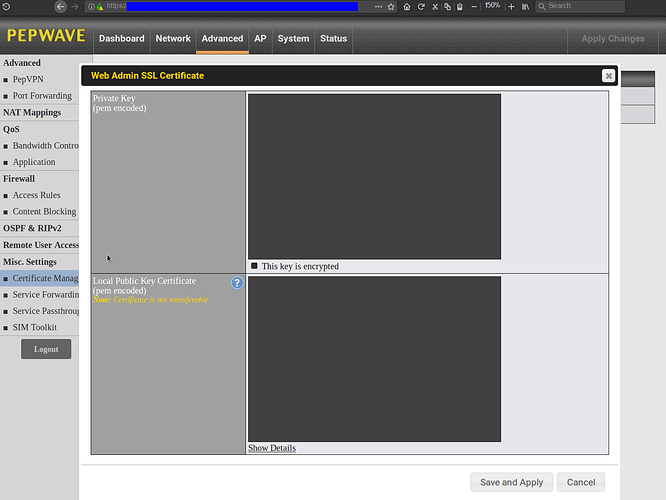I have an idea that maybe some would like to help me with to assist others. When setting up a peplink router right out of the box the most important first step is to simply establish a secure connection to the Web Admin portal. Here is how I would have done it knowing what I know now.
Anyone please feel free to correct or add to this list 
I am definitely not an authority…hence “authoriti” 
Initial Setup of a Peplink Router
Step 1: Write down default access IP address and AP password from back of router.
Step 2: Navigate to that IP address in your browser…initially using http:// and log in with default credentials.
Step 3: Navigate to the AP tab and uncheck “Hide Characters” for the “Shared Key”. Confirm that default “Shared Key” matches that on your router (Step 1). I don’t know of a better way to confirm that one is logged into their router. Make sure the AP is disabled for the time being.
Step 4: In the “System” tab > “Firmware” > “Check for Firmware”…and update to latest version if available. “Save” and “Apply Changes”
Step 5: In the “System” tab > Admin Security…set “Security” as shown. I have left “Web Admin Port” values blank here. Keep the “HTTP:” value the same, but change the “HTTPS” value to a different set of 4 numbers. Also set “Web Admin Access” to “LAN Only” for both. This means that one can only log into the Web Admin when their computer is wired to their router.
“Save” and “Accept Changes”…while remembering or righting down your new 4 digits for your HTTPS:// address.

Step 6: Log off of the Web Admin
Step 7: Log back into the Web Admin but this time using the https:// extension…the IP address…then " : " and your new 4 digit HTTPS:// extension set in Step 5.
Step 8: Firefox or other browsers will raise a flag, but you now know that you are in fact logging into the correct IP address with your new HTTPS 4 digit extension so you can confirm the security exception and then log back into the Web Admin under the HTTPS protocol. Now that you have established a HTTPS:// connection you can feel confident that no one can see your edits in the Web Admin. This is the time you will want to reset credentials.
Step 9: Under “System” Tab > “Admin Security” change your “Admin User Name” and “Admin Password” then “Save” and “Accept Changes”
Step 10: Under “AP” tab > “SSID” … Change your “SSID” name and “Shared Key”… “Save” and “Accept Changes”. Note: This is your WiFi log-in information.
Step 11: Log off the Web Admin and log back in using the HTTPS IP address and confirm your settings. Now would be a good time to enable your AP if you want a WiFi signal.
Step 12: If you find yourself locked out and cannot get back into your Web Admin…Use a pin and hold down the pin hole in your router for 20 seconds. This will bring your router back to factory settings. Of course if you need to do this…that means the instructions here were wrong and need to be corrected 
Again … comments/edits/suggestions welcome !!! 



